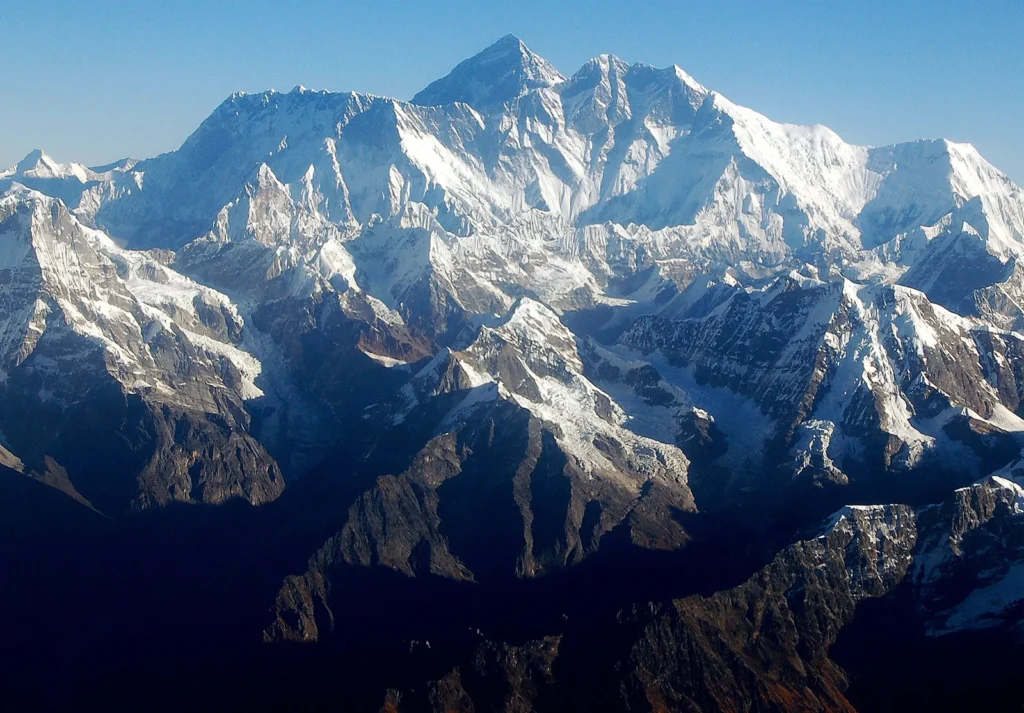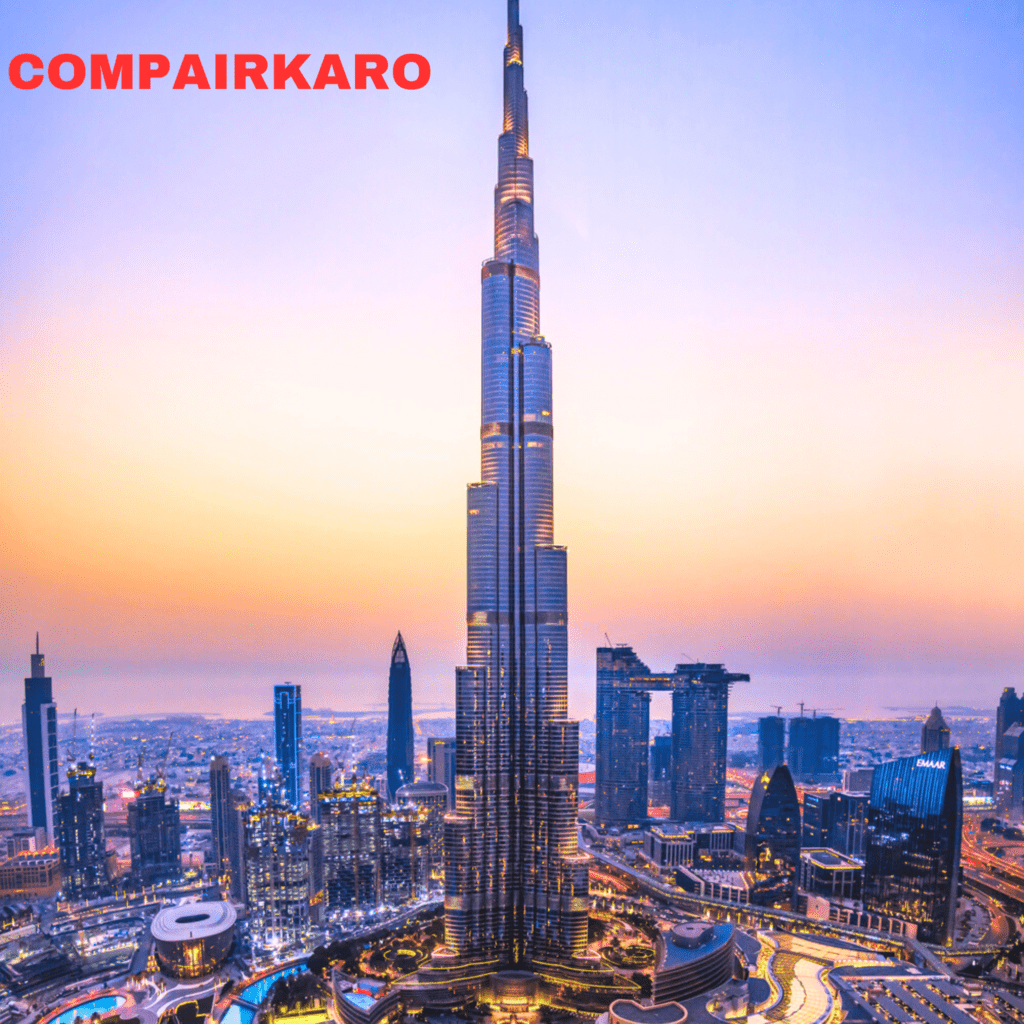Mount Everest vs Burj Khalifa both are an Miracle on this earth.In a world filled with architectural wonders and natural wonders, two towering giants stand above the rest, each representing the pinnacle of human achievement in their own right. Mount Everest, the crown jewel of the Himalayas, reigns as Earth’s highest peak, capturing the hearts of adventurers and explorers for generations. On the other hand, piercing the Dubai skyline with breathtaking audacity, the Burj Khalifa stands as the world’s tallest man-made structure, a testament to human ingenuity and determination. As we embark on this captivating journey of comparison, we’ll delve into the contrasting stories of these awe-inspiring sites – one carved through the ages by the forces of nature, and the other carefully constructed through boundless innovation. Join us as we explore the heights, history and significance of Mount Everest and Burj Khalifa in an epic battle of Earth’s greatest heights.
1. Height and Elevation
- At the pinnacle of Earth’s natural wonders stands Mount Everest, a majestic mountain rising above all other mountains, whose summit reaches an astonishing height of 8,848.86 meters (29,031.7 ft) above sea level. This mighty peak nestled within the breathtaking Himalayas has captivated the imagination of adventurers and mountaineers for centuries. Its towering height, shaped by the forces of nature over millennia, gives it the coveted title of being the tallest mountain in the world.
- In stark contrast to the grandeur of Mount Everest is the remarkable feat of human engineering embodied by the Burj Khalifa. This colossal architectural masterpiece adorns Dubai’s iconic cityscape and reaches an astonishing height of 828 meters (2,717 ft) including its antennas. As the tallest man-made structure on the planet, the Burj Khalifa stands as a testament to human innovation, ingenuity, and determination to push the boundaries of what is possible in the fields of construction and design.
- In this remarkable tale of heights, Mount Everest and Burj Khalifa represent two different sides of human achievement. One is the product of the enduring forces of nature, while the other displays the genius of human imagination and engineering prowess. As we delve deeper into their significance and explore the stories behind these towering giants, we come to appreciate the wonders of our world—a harmonious blend of awe-inspiring beauty created by nature and remarkable feats accomplished by human hands.
2. Natural vs. Man-Made
- Mount Everest stands as the crown jewel of the Himalayas, symbolizing a profound natural wonder shaped by the ancient forces of the Earth. Millions of years of geological processes and collision of tectonic plates resulted in the formation of this grand peak. Everest’s awe-inspiring beauty lies not only in its remarkable height, but also in the way it represents the raw power and artistry of nature, capturing the hearts of explorers and adventurers around the world.
- On the other hand, rising above the vibrant city of Dubai, the Burj Khalifa represents an engineering marvel that epitomizes human innovation and architectural expertise. The construction of such a skyscraper required unprecedented engineering techniques and a visionary mind. Burj Khalifa stands as a symbol of human achievement, pushing the limits of possibility and demonstrating the remarkable capabilities of modern engineering.
- As we compare these two extraordinary entities, we are drawn to appreciate the harmony between the awe-inspiring creations of nature and the genius of human creativity. Mount Everest exemplifies the grandeur and timelessness of natural wonders, while the Burj Khalifa stands as a testimony to humanity’s indomitable spirit to build structures that touch the skies. Each, in itself, symbolizes the conquest of different realms: one created by the forces of nature, and the other, evidence of the limitless potential of human endeavour.
3. Climbing Mount Everest
- Climbing the perilous journey of climbing Mount Everest, climbers face many difficult challenges and life-threatening hazards. Climbing the world’s highest peak requires not only physical endurance but also mental resilience and a keen understanding of the inhospitable terrain.

- One of the most formidable obstacles climbers face is the extreme altitude and thin air. The higher they climb, the lower the oxygen level, which makes it harder to breathe and puts extreme strain on their bodies. This can lead to altitude sickness, which can be fatal if not taken care of. The “death zone”, the area above 8,000 m (26,247 ft), earns its name because of the extremely low oxygen levels, where survival becomes a fierce battle.
- In addition, Everest’s unpredictable and treacherous weather adds an element of unpredictability to climbing. Sudden storms, blizzards and freezing temperatures can come without warning, putting climbers in life-threatening situations and making progress nearly impossible.
- The Khumbu Icefall, a dynamic mass of ice and crevasses, poses another major threat. Traversing this dangerous section requires navigating through unstable ice formations, which has claimed the lives of many climbers over the years.
- Despite the enormous risks, the allure of conquering the world’s highest peak has drawn countless adventurers to summit. Stories of successful expeditions serve as testament to human determination and the will to overcome seemingly insurmountable obstacles. Climbers train rigorously for years, honing their physical strength and mountaineering skills, as well as mentally preparing themselves for the enormous challenges ahead.
- On the other hand, stories of failed attempts remind us of the harsh reality surrounding Mount Everest and the inherent dangers. The tragic incidents of climbers losing their lives during expeditions are a grim reminder of the unforgiving nature of the mountain.
- However, in the midst of these challenges and setbacks, stories of triumph and perseverance continue to inspire. Climbers who successfully scale Everest share courage, camaraderie and a deep sense of accomplishment upon reaching the summit. These stories exemplify the indomitable human spirit and striving to conquer the greatest heights of nature.
In conclusion, climbing Mount Everest represents a difficult and dangerous undertaking, where the line between success and failure is often very thin. The challenges of the mountain demand unwavering determination, physical prowess and a willingness to accept risks. Yet, in the face of these difficulties, climbers demonstrate the resilience and tenacity of the human spirit, and leave behind a legacy of triumph and suffering on the world’s highest platform.
4. Construction of Burj Khalifa
- The construction of the Burj Khalifa, an architectural masterpiece that graces the Dubai skyline, was a marvel of modern engineering and design. The construction process of this awe-inspiring skyscraper showcased state-of-the-art technologies and innovative techniques, resulting in a structure that is unmatched in the world of skyscrapers.

- The project began in 2004, with the aim of building a tower that would surpass all others in height and grandeur. The primary challenges in building such a massive structure included managing the sheer scale and weight of the building while ensuring its stability and safety.
- To achieve this extraordinary feat, the engineers and construction teams applied a strong combination of materials and techniques. Burj Khalifa’s foundation extends deep into the ground, resting on a massive concrete raft that spreads enormous loads on the soil. Reinforced concrete was used throughout the center of the building, providing the necessary strength and stability to maintain its towering height.
- An integral part of the construction was the use of “jump-form” technology, allowing for progressive construction of each floor. This involved building a platform on top of the completed floor, from where construction of the next floor could begin. This continued vertical development enabled efficient and streamlined construction, reducing delays.
- An iconic feature of the Burj Khalifa is its Y-shaped design, inspired by the Hymenocallis desert flower. The Y-shaped plan not only contributes to the building’s aesthetic appeal but also enhances its structural integrity by reducing wind forces acting on the tower.
- The exterior of Burj Khalifa features a unique and attractive cladding system. The cladding, made of reflective glass and aluminum panels, serves both functional and aesthetic purposes. It reflects the sun’s rays, reducing heat absorption and contributing to the tower’s energy efficiency, while also creating a luminous effect that adds to its mesmerizing charm.
- As construction progressed, the Burj Khalifa rose at a remarkable rate. In 2010 the tower reached its full height of 828 meters (2,717 ft), officially becoming the tallest man-made structure in the world.
- The completion of Burj Khalifa is a unique achievement in human engineering and design. Its towering height, innovative construction techniques and captivating design elements make it a symbol of human ambition and architectural excellence. Burj Khalifa’s significance goes beyond its impressive physical stature, serving as a testament to Dubai’s vision and determination to push the boundaries of possibility and leave an indelible mark on the world’s architectural landscape.
5. Geographical Location
1.Mount Everest, the world’s highest peak, is located in the majestic Himalayas, which span several countries including Nepal, China (Tibet), Bhutan, and India. The exact location of Everest lies on the border between Nepal and Tibet (China). Its coordinates place it at approximately 27.9881° north latitude and 86.9253° east longitude.
- The Himalayas, often referred to as the “abode of snow”, are a vast mountain range renowned for their breathtaking beauty and formidable terrain. Mount Everest, with its towering height of 8,848.86 m (29,031.7 ft) above sea level, stands as the ultimate challenge for climbers and adventurers from all corners of the globe.

- The geographical importance of Mount Everest lies not only in its unmatched height, but also in the unique experiences it offers to those who dare to climb its slopes. Climbers encounter the awe-inspiring beauty of the Himalayan landscape with breathtaking views of neighboring peaks, deep valleys and sweeping glaciers. This tough environment presents a test of physical endurance, mental resilience and technical skill, making it an ultimate goal for climbers looking to push their limits.
- Moreover, the allure of Everest is not limited to climbers only. The area around the mountain is a trekkers’ paradise, attracting thousands of adventure seekers every year. The Everest Base Camp Trek is one of the most popular routes, which allows trekkers to experience the beauty of the Himalayas and catch a glimpse of the iconic peak, without even climbing it.
- Additionally, Everest holds cultural and spiritual significance for the people of Nepal and Tibet. It is considered “Sagarmatha” in Nepal and “Chomolungma” in Tibet, both names reflecting its status as a revered deity in local beliefs and traditions.
2. On the other hand, in Dubai, the bustling metropolis of the United Arab Emirates, rises the iconic Burj Khalifa, standing strategically in the city’s central business district. The skyscraper’s location at approximately 25.1972° north latitude and 55.2744° east longitude places it at the center of Dubai’s ever-evolving skyline.
- Dubai is known for its modernity and ambition and the construction of Burj Khalifa exemplifies this spirit. The tower’s strategic location enhances its role as a symbol of Dubai’s aspirations and economic power. The Burj Khalifa, standing at 828 m (2,717 ft), dominates the skyline, demonstrating the city’s grandeur and global influence.

- The strategic position of Burj Khalifa extends beyond aesthetics. It houses residential, commercial and hospitality spaces, making it a multifunctional hub in Dubai’s urban landscape. Its observation deck offers breathtaking views of the city and attracts tourists from all over the world, contributing significantly to the tourism sector and Dubai’s economy.
- In addition, Burj Khalifa serves as a prestigious address for luxury businesses and residences, cementing Dubai’s position as a global economic and cultural hub. Its presence on the skyline reflects the city’s ambition to continually reach new heights and attract international attention and investment.
In conclusion, the geographical location of Mount Everest and Burj Khalifa plays an important role in defining their importance. Mount Everest’s position in the awe-inspiring Himalayas attracts adventurers and trekkers, provides an incomparable experience and serves as a cultural icon. Meanwhile, the Burj Khalifa’s strategic location in Dubai is a symbol of the city’s ambition and economic power, placing it at the forefront of the world’s skyline and economy.
People also Reads :- Colgate Vs Pepsodent
6. Impact on Tourism : Mount Everest Vs Burj Khalifa
1. Mount Everest
- Mount Everest has made a profound impact on the tourism of the region, attracting adventurers, trekkers and climbers from all corners of the globe. As the highest peak in the world, Everest’s allure lies not only in its majestic height, but also in the breathtaking beauty of the Himalayas that surround it. The area around Everest has become a mecca for trekkers wanting to embark on the iconic Everest Base Camp Trek, a journey that provides breathtaking views of snow-capped peaks, picturesque valleys and vibrant Sherpa villages.
- A visit to Everest Base Camp offers trekkers a unique and in-depth experience of Himalayan culture and lifestyle. Along the way, visitors encounter traditional tea houses, monasteries and the warm hospitality of local communities. This cultural exchange and display of the Himalayan way of life makes the Everest region an attractive destination for travelers seeking an authentic and adventurous experience.
- For climbers, climbing Mount Everest represents the ultimate challenge, attended by experienced climbers from all over the world. Reaching the summit requires months of preparation, physical training and logistical arrangements, making it a significant investment for both climbers and expedition companies. Mount Everest’s iconic status as the world’s highest peak has made it a symbol of achievement for climbers and a testament to human perseverance.
- While the allure of Everest has had a positive impact on tourism in the region, it has also brought challenges related to sustainability and environmental protection. The increasing influx of trekkers and climbers has put pressure on the fragile Himalayan ecosystem and local communities. Managing waste, promoting responsible tourism and supporting the welfare of Sherpa communities have become important aspects of ensuring that tourism remains an enduring force for good in the Everest region.
2. Burj Khalifa
- In contrast, the Burj Khalifa in Dubai has become an iconic symbol of modernity and a major attraction for tourists and business visitors. The construction of this massive skyscraper has catapulted Dubai into the global spotlight, cementing its position as a major travel destination.
- The unique design and impressive height of Burj Khalifa make it an architectural wonder that captivates the imagination of visitors. Its observation deck offers breathtaking panoramic views of the city skyline, the vast Arabian desert and the blue waters of the Persian Gulf. Visitors flock to the observation deck to view Dubai’s stunning landscapes from a unique vantage point.
- Dubai’s marketing potential has taken advantage of the Burj Khalifa’s iconic status to attract tourists and business visitors. The tower’s association with opulence and luxury is in line with Dubai’s reputation as a modern, vibrant and cosmopolitan city. As a result, Burj Khalifa has become a symbol of Dubai’s economic prosperity and ambition, attracting investors and businesses from around the world.
- The tower’s strategic location in Dubai’s central business district also makes it a hub for corporate events, meetings and conferences. Business travelers flock to Dubai, attracted by the city’s status as a global business center, with the Burj Khalifa serving as a prominent landmark and an impressive venue for various corporate activities.
In conclusion, both Mount Everest and Burj Khalifa have left a lasting impression on tourism, in different ways. Mount Everest’s allure as the world’s highest peak attracts adventurers and climbers looking for the ultimate challenge, while trekkers are attracted by its natural beauty and cultural experiences. On the other hand, the Burj Khalifa has become a symbol of Dubai’s modernity, attracting tourists and business visitors with its iconic design and strategic location at the heart of the city’s skyline. Both the sites serve as testimony to human achievement and continue to shape the tourism landscape of their respective regions.
7. Environmental Considerations
1. Mount Everest
- Climbing Mount Everest presents significant environmental concerns, mainly related to waste management and the ecological impact on the fragile Himalayan ecosystem. Due to the ever-increasing number of climbers and trekkers, a considerable amount of garbage is being generated in the Everest region. Campsites along climbing routes and trekking trails are often littered with disused equipment, food wrappers and human waste, posing a threat to the pristine environment.
- Various initiatives have been taken to address these challenges. Environmental organizations along with the Nepalese and Tibetan governments have launched campaigns to raise awareness of responsible trekking and climbing practices. Mountaineering expeditions must now take out their waste and ensure that it is properly disposed of at designated waste disposal areas.

- In recent years, the Everest region has seen clean-up campaigns to remove accumulated waste from base camps and climbing routes. Efforts to reduce the ecological impact include educating climbers and trekkers about “leave no trace” principles, urging them to reduce waste generation, use biodegradable materials, and take back all their trash.
- Another important concern is the impact of increasing human traffic on the fragile Himalayan ecosystem. As the number of climbers and trekkers increases, there is increasing pressure on natural resources including water and fuel wood. This can disrupt the delicate balance of the local environment and put a strain on the scarce resources available to the indigenous communities living in the area.
- To address ecological concerns, responsible trekking and mountaineering practices focus on minimizing the use of natural resources. Base camps attempt to rely on alternative energy sources such as solar power for heating and lighting. Additionally, controlled waste management and recycling programs have been introduced to reduce the overall ecological footprint of Everest expeditions.
2. Burj Khalifa
- With respect to the Burj Khalifa, during its construction and ongoing maintenance, sustainability and green practices have been integrated into its design and operation. The tower has been awarded the Leadership in Energy and Environmental Design (LEED) Gold certification for its environmentally conscious initiative.
- To reduce energy consumption, Burj Khalifa uses advanced energy-efficient technologies, including high-performance glass for insulation and state-of-the-art air-conditioning systems. The tower’s design also includes wind turbines and solar panels, which use renewable energy sources to partially power the building.

- Water conservation is another important aspect of sustainability at Burj Khalifa. The tower utilizes advanced water recycling and desalination technologies, reducing water usage and contributing to Dubai’s efforts to address water scarcity challenges.
- In addition, Burj Khalifa encourages the use of public transportation and eco-friendly mobility solutions for visitors and tenants. Access to electric vehicle charging stations and bike-sharing facilities promote green transportation options.
- As part of its commitment to sustainability, Burj Khalifa is also actively engaged in community initiatives, promoting environmental awareness and participating in various environmental protection programs.
In conclusion, both Mount Everest and Burj Khalifa have faced environmental challenges and implemented measures to reduce their ecological impacts. Climbing Mount Everest has raised concerns about waste management and its impact on the fragile Himalayan ecosystem. Initiatives that focus on responsible tracking practices and environmental education are vital to preserving the natural beauty of the area. On the other hand, the construction and maintenance of the Burj Khalifa incorporated sustainability initiatives including energy-efficient technologies, renewable energy sources and water conservation measures, making it a model for environmentally conscious skyscrapers.
8. Human Endeavor and Achievement
1. Mount Everest
- At the core of Mount Everest summits and record-breaking skyscrapers lies the indomitable human spirit of adventure and exploration. It is this inner longing to venture beyond the known, to conquer the seemingly insurmountable, that drives climbers to climb the world’s highest peak and engineers to design and erect architectural marvels such as the Burj Khalifa.
- Mount Everest, with its towering presence and formidable challenges, represents a symbol of human ambition. The desire to stand on the highest point on earth drives climbers to push their physical and mental limits to the extreme. Enduring grueling training, acclimatization, and unpredictable weather conditions, they traverse treacherous terrain, and often overcome seemingly insurmountable obstacles.
- In the face of adversity, climbers demonstrate unwavering determination and a will to endure, exemplifying the triumph of the human spirit against the forces of nature. Each successful climb of Everest is not only a symbol of individual achievement, but a testimony to human perseverance and the constant quest to conquer the unstoppable.
2. Burj Khalifa
- Similarly, in the fields of engineering and architecture, the construction of record-breaking skyscrapers such as the Burj Khalifa is a symbol of boundless human imagination and innovation. Engineers and architects strive to push the boundaries of what can be built, taking advantage of cutting-edge technologies and creative design solutions to achieve the unattainable.
- The quest to build higher, more awe-inspiring structures challenges engineers to solve complex engineering problems and overcome significant constraints. From the use of advanced materials to innovative manufacturing techniques, each element is a testament to human ingenuity and our ability to think beyond the constraints of the present.
- The towering presence of Burj Khalifa on Dubai’s skyline is a reminder of humanity’s progress and our ability to shape the world around us. It symbolizes our desire to create a monument that will leave a lasting impression, transcend generations and inspire future endeavours.
- These achievements, whether conquering the world’s tallest peaks or building groundbreaking skyscrapers, push the limits of human capabilities and inspire us to aspire to greatness. They remind us that the human spirit is not limited by boundaries, and that with determination, innovation, and persistence, we can overcome any obstacle in our path.
In conclusion, the human spirit of adventure and exploration, the driving force behind phenomenal architectural feats such as the Mount Everest summit and the Burj Khalifa, exemplifies the constant pursuit of human endeavour. These achievements stand as symbols of human ambition, demonstrating our ability to explore the unknown and push the limits of human capabilities. They inspire generations to come, reminding us that when driven by passion and determination, there are no limits to what humanity can achieve.
9. Iconic Status
Both Mount Everest and Burj Khalifa hold enormous cultural and symbolic significance globally, having gone beyond their physical attributes to become symbols of national pride and human ingenuity for their respective countries.
1. Mount Everest
- Standing high in the Himalayas, Mount Everest is a symbol of human achievement and natural wonder. Its towering peak represents the ultimate challenge for climbers and adventurers around the world, making it a symbol of human perseverance, bravery and the indomitable spirit of exploration. Everest’s cultural significance goes far beyond its height, as it holds sacred value to the indigenous communities of Nepal and Tibet. Known as “Sagarmatha” in Nepal and “Chomolungma” in Tibet, it is revered as the “goddess of the sky” and symbolizes a deep spiritual connection with the land and its people.
- The successful ascent of Mount Everest has become a matter of national pride for Nepal and Tibet, and each successful climber is celebrated as a hero. The mountain has become a powerful symbol of national identity and a testimony to the strength and resilience of its people. It also fosters a spirit of camaraderie and international co-operation, as climbers from different countries come together to attempt this mammoth challenge.
2. Burj Khalifa
- On the other hand, Burj Khalifa represents a symbol of Dubai’s prominence on the global stage. Its awe-inspiring height and architectural magnificence have made it a powerful symbol of human ingenuity and modernity. The construction of the Burj Khalifa was a turning point for Dubai, catapulting it from a regional city to an international metropolis.
- Dubai, as a city, has adopted the Burj Khalifa as a symbol of its ambition and visionary vision. The skyscraper’s distinctive design and towering presence on the skyline has become synonymous with the city’s economic prosperity and cosmopolitan lifestyle. Burj Khalifa stands as an expression of Dubai’s determination to create an innovative and futuristic urban landscape that captures the attention of the world.
- Furthermore, the symbolism of Burj Khalifa extends beyond the borders of Dubai, representing a global pursuit of architectural excellence and pushing the boundaries of possibility. It serves as a testament to human creativity and engineering prowess, inspiring architects and designers around the world to dream big and bold.
In conclusion, both Mount Everest and Burj Khalifa have transcended their physical attributes to become globally iconic symbols. Mount Everest represents the pinnacle of human achievement in mountaineering and exploration, while holding spiritual significance for the people of Nepal and Tibet. It is a symbol of national pride and a reminder of the courage of the human spirit to venture into the unknown. On the other hand, the Burj Khalifa is a symbol of Dubai’s meteoric rise as a global city and a symbol of modernity. Its architectural marvel represents human ingenuity and innovation, inspiring generations to push beyond the limits of the possible. Together, they demonstrate the richness of our collective human heritage, connecting cultures and uniting people in pursuit of excellence and a brighter future.
10. Lessons Learned
As we reflect on the remarkable stories of Mount Everest and Burj Khalifa, we uncover valuable lessons that go beyond their physical grandeur and architectural brilliance.
1. Mount Everest
Firstly, the lofty peak of Mount Everest reminds us of the utmost importance of respecting and preserving the wonders of nature. The Himalayas, with their awe-inspiring beauty, delicate ecosystem and spiritual significance, deserve our utmost care and reverence. As adventurers and tourists, it is our responsibility to explore these natural landscapes with humility and sustainable practices, leaving behind only footprints and memories. The environmental impact of tourism and mountaineering serves as a poignant reminder that our pursuit of adventure must be balanced with a deep sense of responsibility to the planet we call home.
2. Burj Khalifa
Secondly, Burj Khalifa stands as a testament to the limitless power of human innovation and ingenuity. From the drawing board to its towering presence on the skyline, the skyscraper reflects the heights of human achievement. It encourages us to dream beyond imagination, challenge the status quo and push the boundaries of what is possible. Burj Khalifa inspires us to embrace the spirit of constant pursuit and to continually strive for excellence not only in architecture and engineering but in all aspects of our lives.
- Additionally, both milestones exemplify the spirit of human endeavor and perseverance. Climbing Mount Everest and building the Burj Khalifa required unwavering determination, courage and a willingness to overcome adversity. These achievements teach us the importance of resilience and the value of perseverance in the face of challenges. They remind us that greatness is not achieved easily but by the willingness to persevere and overcome obstacles that stand in the way of success.
- Furthermore, both Mount Everest and Burj Khalifa demonstrate the power of unity and cooperation. Climbing the world’s tallest peak and building the tallest tower involved a concerted effort by diverse teams from different countries and disciplines. These achievements exemplify the power of working together, transcending borders and cultural barriers, to achieve shared goals.
In conclusion, Mount Everest and Burj Khalifa have left an indelible mark on our collective consciousness, teaching us important lessons that go beyond their physical grandeur. They call on us to cherish and protect the natural wonders of our planet, while also inspiring us to dream big and reach higher through human innovation and collaboration. The stories from these extraordinary places remind us of the potential within each of us to strive for greatness, to embrace challenges and to leave a lasting legacy that enriches humanity and the world we live in.
FAQ’S BY PEOPLE
Is Mount Everest bigger than the Burj Khalifa?
Yes , Mount Everest is the highest mountain in the world at 8,848 meters (29,029 feet).
Is there a building bigger than Mount Everest?
NO
Is there anything bigger than Burj Khalifa?
Jeddah Tower is located in Jeddah, Saudi Arabia. Once complete, the Jeddah Tower will stand at least 3,300 feet (1,000 meters) tall, 500+ feet taller than Burj Khalifa.
Is Burj Khalifa taller than Kilimanjaro?
In fact, it’s over seven times taller than the tallest manmade structure on Earth – the 2,717-foot Burj Khalifa.
How many Burj Khalifa can fit in Mount Everest?
The answer is approximately 11! This is because the Burj Khalifa’s height is around 2,717 feet, which is around eleven times shorter than Mount Everest.




